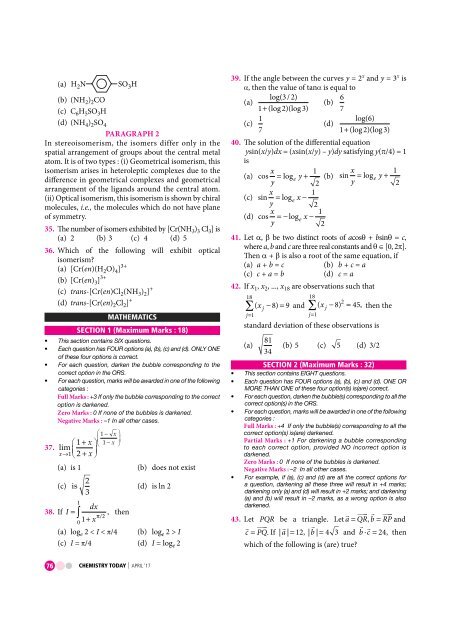Chemistry_Today_April_2017_vk_com_stopthepress
Create successful ePaper yourself
Turn your PDF publications into a flip-book with our unique Google optimized e-Paper software.
(a) HN 2 SO 3 H<br />
(b) (NH 2 ) 2 CO<br />
(c) C 6 H 5 SO 3 H<br />
(d) (NH 4 ) 2 SO 4<br />
PARAGRAPH 2<br />
In stereoisomerism, the isomers differ only in the<br />
spatial arrangement of groups about the central metal<br />
atom. It is of two types : (i) Geometrical isomerism, this<br />
isomerism arises in heteroleptic <strong>com</strong>plexes due to the<br />
difference in geometrical <strong>com</strong>plexes and geometrical<br />
arrangement of the ligands around the central atom.<br />
(ii) Optical isomerism, this isomerism is shown by chiral<br />
molecules, i.e., the molecules which do not have plane<br />
of symmetry.<br />
35. The number of isomers exhibited by [Cr(NH 3 ) 3 Cl 3 ] is<br />
(a) 2 (b) 3 (c) 4 (d) 5<br />
36. Which of the following will exhibit optical<br />
isomerism?<br />
(a) [Cr(en)(H 2 O) 4 ] 3+<br />
(b) [Cr(en) 3 ] 3+<br />
(c) trans-[Cr(en)Cl 2 (NH 3 ) 2 ] +<br />
(d) trans-[Cr(en) 2 Cl 2 ] +<br />
MATHEMATICS<br />
SECTION 1 (Maximum Marks : 18)<br />
• This section contains SI questions.<br />
• Each question has FOUR options (a), (b), (c) and (d). ONLY ONE<br />
of these four options is correct.<br />
• For each question, darken the bubble corresponding to the<br />
correct option in the ORS.<br />
• For each question, marks will be awarded in one of the following<br />
categories :<br />
Full Marks : +3 If only the bubble corresponding to the correct<br />
option is darkened.<br />
Zero Marks : 0 If none of the bubbles is darkened.<br />
Negative Marks : –1 In all other cases.<br />
39. If the angle between the curves y = 2 x and y = 3 x is<br />
α, then the value of tanα is equal to<br />
log( 3/ 2)<br />
6<br />
(a)<br />
(b)<br />
1+<br />
(log 2)(log 3)<br />
7<br />
1<br />
log( 6)<br />
(c)<br />
(d)<br />
7<br />
1+<br />
(log 2)(log 3)<br />
40. The solution of the differential equation<br />
ysin(x/y)dx = (xsin(x/y) – y)dy satisfying y(/4) = 1<br />
is<br />
x<br />
(a) cos = loge<br />
y + 1 y<br />
2 (b) x<br />
sin = loge<br />
y + 1 y<br />
2<br />
x<br />
(c) sin = loge<br />
x − 1 y<br />
2<br />
x<br />
(d) cos =−loge<br />
x − 1 y<br />
2<br />
41. Let a, b be two distinct roots of acosq + bsinq = c,<br />
where a, b and c are three real constants and q [0, 2].<br />
Then a+ bis also a root of the same equation, if<br />
(a) a + b = c<br />
(b) b + c = a<br />
(c) c + a = b<br />
(d) c = a<br />
42. If x 1 , x 2 , ..., x 18 are observations such that<br />
18<br />
j=<br />
1<br />
18<br />
∑( x j − 8)<br />
= 9 and ∑( x j − 8) 2 = 45,<br />
then the<br />
j=<br />
1<br />
standard deviation of these observations is<br />
81<br />
(a) (b) 5 (c) 5 (d) 3/2<br />
34<br />
SECTION 2 (Maximum Marks : 32)<br />
• This section contains EIGHT questions.<br />
• Each question has FOUR options (a), (b), (c) and (d). ONE OR<br />
MORE THAN ONE of these four option(s) is(are) correct.<br />
• For each question, darken the bubble(s) corresponding to all the<br />
correct option(s) in the ORS.<br />
• For each question, marks will be awarded in one of the following<br />
categories :<br />
Full Marks : +4 If only the bubble(s) corresponding to all the<br />
⎛1<br />
− x ⎞<br />
correct option(s) is(are) darkened.<br />
⎜ ⎟<br />
⎛ 1 + x ⎞⎝<br />
1 − x ⎠<br />
Partial Marks : +1 For darkening a bubble corresponding<br />
37. lim<br />
to each correct option, provided NO incorrect option is<br />
x<br />
⎜<br />
→ ⎝ + x<br />
⎟<br />
1 2 ⎠<br />
darkened.<br />
(a) is 1<br />
(b) does not exist<br />
Zero Marks : 0 If none of the bubbles is darkened.<br />
Negative Marks : –2 In all other cases.<br />
• For example, if (a), (c) and (d) are all the correct options for<br />
2<br />
(c) is<br />
(d) is ln 2<br />
a question, darkening all these three will result in +4 marks;<br />
3<br />
darkening only (a) and (d) will result in +2 marks; and darkening<br />
(a) and (b) will result in –2 marks, as a wrong option is also<br />
1<br />
dx<br />
darkened.<br />
38. If I = ∫ , then<br />
1<br />
π/ 2<br />
0<br />
+ x<br />
43. Let PQR be a triangle. Let <br />
a= QRb , = RP and c = PQ.<br />
<br />
(a) log e 2 < I < π/4 (b) log e 2 > I a= QRb , = RP and c = PQ.<br />
If | <br />
a| = 12,| b|<br />
= 4 3 and <br />
b⋅<br />
c =24, then<br />
(c) I = π/4 (d) I = log e 2<br />
which of the following is (are) true?<br />
76 CHEMISTRY TODAY | APRIL ‘17


